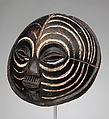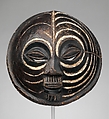Mask (Kifwebe)
Not on view
Striated face masks known as <em>kifwebe</em> were historically created by sculptors in an area of the Zaire River Basin inhabited by both Songye and Luba communities. Significant departures in the role and formal interpretation of this sculptural genre subsequently developed in each culture. In both instances, <em>kifwebe</em> masks participated in initiations and played a role in establishing order in society. Round striated Luba <em>kifwebe</em> function within benevolent practices that purify the community of the evil spirits of sorcerers. In performance, this mask was complemented by a costume ensemble comprising woven textiles, animal pelts, and plant fibers, which covered the dancer's body.
The 1966 Dakar exhibition included works lent by museums from across the African continent as well as private and institutional European and American collections. An American advisory committee was formed that included MPA's director Robert Goldwater. Goldwater chaired the U.S. contributions to the exhibition of traditional art, and traveled to Dakar to participate in the symposium organized to complement the exhibition. The American Committee sent sixty of the five hundred works on view in Dakar, and the MPA was the most generous of the lenders. The active involvement of the MPA in this endeavor complemented Rockefeller's political ideals concerning the role of art in furthering international dialogue as well as his desire to connect with the source countries of the works he collected so passionately.
Due to rights restrictions, this image cannot be enlarged, viewed at full screen, or downloaded.
This artwork is meant to be viewed from right to left. Scroll left to view more.






